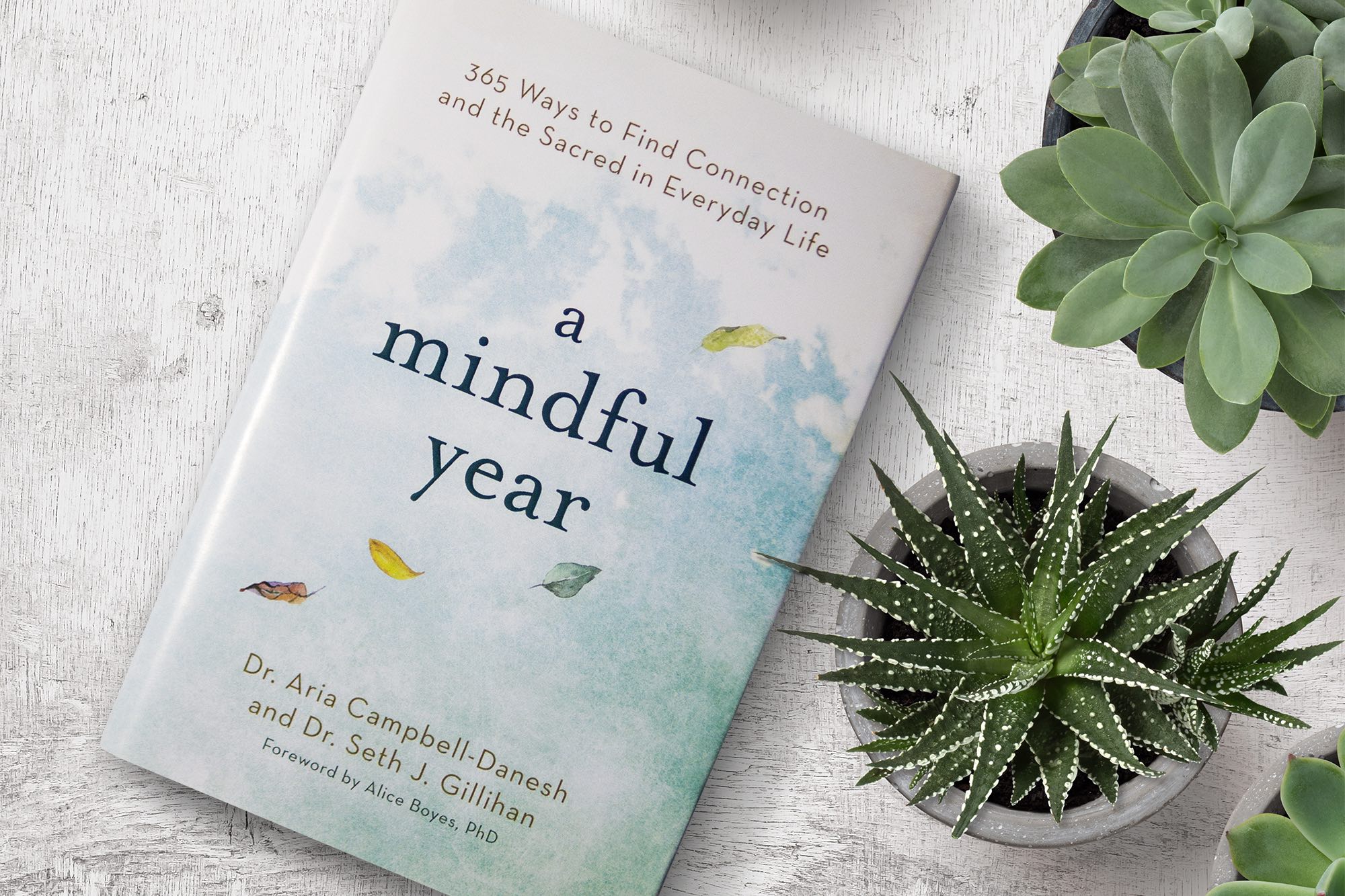This Main Line Psychologist’s Book of Daily Mindful Practices is the Wellness Boost You Need
A Mindful Year — the book out today from Haverford-based clinical psychologist Seth Gillihan and his friend, Aria Campbell-Danesh — is a lovely add to your wellness toolbox.

Seth J. Gillihan, a local psychologist, partnered with fellow psychologist Aria Campbell-Danesh to write a book of daily mindful practices. / Photograph courtesy of Lauren Maturo
I believe that everyone has soulmates. Not in the traditional sense, in that one person meets all your needs or that you marry this human and he/she/they becomes your life partner. Instead, I think soulmates are the people (plural) who understand you intimately at first meeting. Who never need further explanation when you make a statement. Who start your sentences as much as finish them.
Some people might call this relationship a friendship, but I think there’s something more there. We have friends who we only go to the gym with, who we grab coffee with when we’re in town, whose texts start with “Hey, how’s it going?” Soulmates, in contrast, send you a random link followed by incoherent words that only make sense to you.
Or, in Seth J. Gillihan and Aria Campbell-Danesh’s case, they write each other letters. The two clinical psychologists met when Campbell-Danesh took Gillihan’s “Anxiety and the Brain” seminar at the University of Pennsylvania. The two would talk about mindfulness after class (Campbell-Danesh had just created Penn’s first mindfulness group) and quickly became friends, a connection they maintained when Campbell-Danesh, a visiting student, returned to Scotland.
When they decided to write a book together around the concept of daily mindful practices, they figured it would be more fun to incorporate anecdotes from their own lives and write what amounted to a full year of diary entries they shared with each other. “Making plans in 2016 to start January 1st of 2017, I didn’t know what was in store for me that year and how much I would need the daily encouragements I got from Aria,” Gillihan says. “It ended up being the hardest year in my life.”
The resulting book, A Mindful Year: 365 Ways to Find Connection and the Sacred in Everyday Life, out today, reads like a more evidence-based Co-Star report, with personal tidbits that bring the practices beyond theory and ground them firmly in reality. Each day, there is a different quote, mini essay, and actionable suggestion, all of which are intended to inspire you to make small changes in your life that could end up having a huge impact.
For example, today’s entry starts with a quote from Eleanor Roosevelt: “If life were predictable, it would cease to be life, and be without flavor.” The next few paragraphs talk about either Gillihan or Campbell-Danesh (sometimes it’s difficult to tell who) defending his thesis as part of getting his doctorate and being pleasantly surprised at how enjoyable the typically strenuous experience was. At the bottom of the page is an “invitation” that reads, “Find your own way to embrace the unpredictability of the day ahead. See if you can appreciate the fullness of the unknown.” They’re nice little reminders to change the way you view the world.
But I wanted to know more. So, in advance of the book’s release, I chatted with Gillihan to get extra details about the writing process, what happened during his mindful year, and how a friend lifted him up throughout.
How did you come up with the idea to write a book and to do so by writing letters to each other?
We’d done other mini collaborations — he had guest blogged on my blog — and there was something that seemed more durable about a book. It’s easy to share with others. And I found that my most fruitful work is in close collaboration with people I care about. We hadn’t spent a ton of time together but had had developed quite a deep bond and seemed to connect easily. We felt like this would be a great opportunity to develop whatever that connection was.
We were both really into the idea of doing little things consistently that end up having a big effect on our lives and moving us in the direction we want to go, and I came up with this daily practice idea. The thought of sitting down at least for me and writing 182 of these entries felt like it’d be really boring, so we said, ‘Why don’t we do this in real time? Let’s do the exercises ourselves and write one per day and write to each other.’ It was also an excuse to be in touch with each other every day.
You mentioned that you ended up really needing this human connection during a difficult year. What happened?
The main struggle was these chronic health issues. I was having a lot of vocal difficulties. I had voice surgery to remove a benign growth but continued to struggle with frequent bouts of losing my voice. That’s difficult in my profession as a talk therapist; I could only [makes gargling sounds] so much. There were months where I would speak virtually not a single word at home. I cascaded into profound bouts of low energy and had vague neurological symptoms — memory issues and brain fog, horrible insomnia, digestive issues. Diving into it more, it’s such a common story now. You see all the specialists, and no one really has an answer. They say your brain scan looks great, and you should be fine.
A few months into the year, I spiraled into a pretty profound depression, which took me a while to recognize. Books I expected I’d love had no stickiness to them. I was irritable all the time. I had this downward spiral of not having the energy and voice to get together with friends. But I am so thankful that I had those experiences. The spiritual growth and connection that they led to couldn’t have happened without having gone through them. I wouldn’t want to repeat them — I’m glad I’m through the worst of them, but it seems so much easier to understand now when people say crazy thoughts.
The book title is A Mindful Year — how do you define mindfulness?
The pithiest definition I can give is just opening to reality as it is. Built into that idea is being present — being aware of what’s happening in the present and being open to it, not fighting it, not resisting it. I think those two really are kind of inseparable. If we’re open to what’s happening, we’re going to be in the moment. If we’re truly present, we’re going to be open. Not constantly judging, ‘Is this good for me, is this bad for me?’ But I actually don’t think we thought of it initially as a book on mindfulness. What we were really after was connection. But A Mindful Year is a way better title than A Really Difficult Year That Ended Up Being Writing Back and Forth With a Friend.
How did Campbell-Danesh help you during that difficult period?
There were times where we spoke by phone when I was having a tough time. So many of the practices that we offer have specific memories of times coming home. There were many times I would cry on my way to work or cry as I walked home, feeling like I just wanted to quit. I remember coming home and walking up this hill, this little baby hill, feeling like I could barely make it up it. I wasn’t looking forward to that night. I was thinking, ‘I’m going to be such a downer with my family.’
But I remembered the practice Aria offered for that day, and it changed things for me. I had a completely different night than I would have had otherwise. Just that moment and that reminder reset my rudder in a way. It was helpful to be forced to keep thinking of ways to find strength and to use the challenges that I was having to hopefully encourage others to find ways to recognize their value and to connect with people that can lift them up — to be of service when you feel like you have nothing to offer
I know a lot of this is based in cognitive behavioral therapy – what kinds of CBT principles show up in the book?
There are three big ones — the cognitive one is really starting with greater awareness of our thoughts. We participate in our thoughts as though they’re a pure reflection of reality, and it’s a matter of becoming aware that the things we’re telling ourselves are often stories about reality. Like, ‘My kids would be better off with a different dad.’ It’s a story, but we see it as, ‘The sky is blue.’ Many times in the book, we talk about fostering a friendlier relationship with ourselves through our thoughts — noticing the constantly critical and badgering or berating voice and replacing it with a more supportive one that we would use when talking with someone we love — or at least not someone we hate.
The behavioral ones involve planning intentional activities that move us toward things we care about. It’s so easy to have these intentions and believe that we’re doing everything we can to move toward them but to keep putting them off. Is there a dream you’ve had that you’ve put on hold? Are there relationships you want to strengthen? It’s about offering a small act that could get momentum going.
Then the mindfulness component is being aware of things we usually take for granted — we have entries on noticing all the ways that water graces our lives, sounds we usually take for granted, the home we inhabit and noticing what makes it home. It’s greater participation in a life that’s already ours.
What about the quotes that start each entry? They come from quite diverse sources — Bob Marley, the Bible, Rumi, Eleanor Roosevelt.
Some of them were ones that I already knew that I loved and wanted to include. Sometimes there was an artist I wanted to reference. I think that was the year Tom Petty died, so I probably included one around the date of his death. For a lot of them, there were things I was reading at the time. Other times, I had a topic in mind and turned to google and googled quotes on such and such. I did like the diversity. We weren’t squeamish about using verses from the Bible. Originally we had a quote from Louis C.K. but because of more recent events, we took it out. It was a great quote but too contaminated at this point.
How do you hope people use this book?
Ideally, we’d like them to use it more days than not. I think there is value in the consistency. But realistically, people are probably going to come and go from the book. They’ll go through periods where they use it and then life happens and they fall away from it a little bit. Hopefully they’ll leave it out so they can see it, so there’s that visual reminder to come back to it. We tried to with our edits make it so that you can pick it up whenever — people wouldn’t have to go back and read to get prior knowledge.
Do you have any favorite entries?
There are two that come to mind. The one I love about Christmas is just so joyful. My wife and I had had a lot of difficulty having kids, and our first child was born on Christmas day almost 12 years ago. So there was so much joy and the light in that. I was happy with how that one turned out. There’s actually another entry about struggle that talks about the pain of losing multiple pregnancies and not being able to conceive for a long time, and how in hindsight, I feel like that experience, even as it broke my heart, it also softened it. It was something I didn’t realize until I was writing it, even having been a therapist for a while.
One other one that comes to mind is about mountains. I talk about my experiences as a kid — my dad would drive us up into the mountains in northern California, and as we’d drive up, it would get cooler. We’d step out, and there would be no cars, no buildings or anything around. He’d tell us, ‘Listen, just listen.’ At the time, I’m four or five, maybe five or six, I didn’t know what I was listening for. Later on, my wife and I were living in Bar Harbor, Maine, where the mountains meet the sea. I realized as I was writing one sometime in July that when I died, I wanted my ashes to be sprinkled on Dorr Mountain, in Acadia National Park where we had hiked together. It was bringing it all full circle. Now when I visit the mountains, I know what my dad was listening for.


